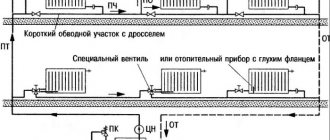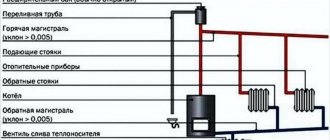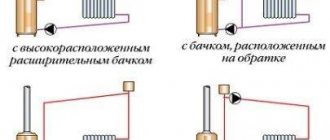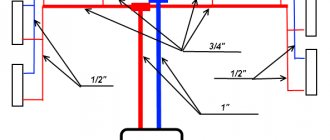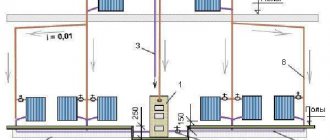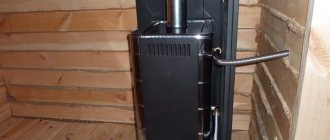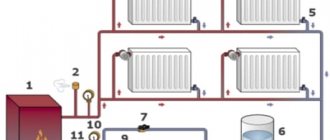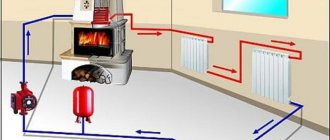Modern autonomous heating systems are equipped with a forced circulation pump. However, turning off the electricity supplying the unit leads to a complete cessation of heating, regardless of the boiler equipment and fuel used. Homeowners solve this problem in 3 ways: using an uninterruptible power supply, a generator, or arranging a circuit with natural circulation. Having made heating in a private house without a pump with your own hands, you don’t have to worry about possible power outages.
How to make heating in a private house without a plastic pump by gravity: calculation of a gravity system
Installing a gravity heating circuit carries the risk of having an ineffective heating system. Inaccuracies in design and installation can lead to the boiler boiling and the coolant not moving in the pipes. In order for the gravity system to work properly, it is pre-calculated by determining the power of the boiler unit, geometric parameters and length of pipelines.
Natural circulation of the medium in closed or open vessels is carried out due to gravity. When heated, the density decreases, causing cold layers to sink down and warm layers to rise up. In order for this physical effect to ensure the circulation of coolant through the pipelines, the heating system must have a number of design features:
- The diameters of the inlet and outlet pipes of the boiler unit must be at least 40 mm.
- At the outlet of the boiler, an accelerating riser must be installed, which ends in an expansion tank.
- Heating pipes are laid with a slight slope towards the inlet pipe.
An important criterion for heating efficiency is the speed of movement of the coolant. In modern systems, water circulation is provided by pumps. In them, the speed varies widely and can reach several meters per second. For gravity contours, this figure does not exceed 0.25 m/s.
Based on the maximum speed, the system is calculated and the pipeline diameters are selected:
- Determine the amount of heat required to heat the building. As a rule, for every 10 m2 of area there is 1 kW of thermal energy.
- Calculate the amount of coolant. To do this, the thermal energy is divided by the temperature difference between the supply and return and multiplied by a correction factor equal to 0.86.
- Calculate the flow area and pipe diameters. The first parameter is determined by multiplying the volume of the coolant by the accepted speed of water movement and dividing by 3600. Knowing the cross-sectional area, determine the minimum diameter of the pipe, and then compare the obtained value with the produced range and select the nearest larger specimen.
Attention!
If the heating system is formed from several circuits, an individual calculation is performed for each individual branch.
System installation
When designing a water-type heating circuit without a pump, you need to correctly position the boiler and lower radiator. The higher the battery is in relation to the boiler equipment, the worse the outflow. It is better to install heating devices in the basement. The coolant circulation rate is affected by:
- pipe section. As the diameter of the pipeline decreases, the resistance provided to the coolant increases;
- pipe material. It is better to use polyurethane products;
- number of bends. With a decrease in quantity, the efficiency of the heating circuit increases. Productivity depends on the number of shut-off valves.
Installation work
To calculate the power of boiler equipment, you need to apply the recommendations of SNiP. For one square meter of heated space, a heating element with a power of 0.1 kW is needed. When installing a heating unit, it is necessary to insulate the hot water riser and the room with the expansion tank.
Installation work: install the main riser. An expansion tank is mounted on top. Connect the wiring at 1/3 of the height of the room from the floor. The pipes are led to the radiators. Single-pipe wiring involves connecting pipes to the boiler from the last radiator. Two-pipe - parallel connection of batteries, insertion of branches into a common pipeline.
How to make heating yourself without a polypropylene pump
Polypropylene pipes have gained popularity due to their affordable price, quality of material and ease of installation. Even a beginner can cope with the assembly; all you need to do is buy or rent a soldering iron - a special heater designed to connect elements together.
The amorphous nature of the polymer to an aggressive environment under the influence of high temperatures is the key to the longevity of the system. The material provides minimal resistance to the directional movement of the coolant, which makes the circuit of polypropylene pipes most suitable for organizing gravitational circulation of liquid.
Sequence of work:
- Mark the installation locations of batteries, connection points for connections and highway routes. The diagram is drawn on the walls, starting from the farthest section, gradually approaching the combustion room where the boiler will be installed. The mains should have a slope of 2 to 8 mm.
- After applying the markings, it is determined at what level the boiler should stand. The inlet pipe should not be higher than the return line. If this condition is not met, the markings will need to be adjusted or a pit will be constructed to bury the boiler unit.
- They punch holes in the partitions and cut grooves for the hidden gasket.
- Carry out a control check that the markings are applied correctly and begin installation. First, radiators are installed, then the connections are assembled and the lines are laid.
The assembled circuit is slowly filled with water through the make-up tap at the lowest point. The air from the pipes will go into the expansion tank. To fill the batteries, use a manual air vent.
Wiring diagrams
There are a LOT of specific examples and diagrams of how heating with natural circulation can be implemented with your own hands. We will give one example of the simplest solutions for two-pipe and one-pipe wiring.
Two-pipe
Wiring of two-pipe heating with natural circulation.
Symbols on the diagram:
- Boiler.
- An expansion tank, which serves to compensate for changes in the volume of the coolant during temperature fluctuations and collects displaced air.
- Heating devices - convectors or radiators.
T1 is water heated by the boiler, T2 is cooled water. Red and blue arrows show the direction of movement of the coolant.
Here, when wiring, the same basic principles that were listed above are relevant:
- The boiler is installed as low as possible below the radiators.
- A slope of 5-7 degrees is made along the water flow.
- Bottlings where several radiators are powered from them are carried out with a pipe no lower than DN32 mm. Preferably polymer or metal-plastic. Connections to radiators are traditionally made with a DN20 pipe.
Important: do not confuse the DN, which is approximately equal to the internal cross-section of the pipe, with its external diameter. In the case of polypropylene, an outer diameter of 32 millimeters corresponds to only DN20.
Two-pipe heating of a private house with natural circulation with correctly selected pipe diameters does not require balancing, however, chokes on the connections to the radiators will not interfere.
The presence of two circuits around the entire perimeter of the house will be quite expensive: the price of polypropylene reinforced pipes is not so small, and the installation itself will take considerable time. Therefore, for most one-story houses, single-pipe wiring is used.
Single-pipe
The simplest single-pipe barrack-type scheme is Leningradka.
The slope and diameter of the pipes are the same here. There are several nuances that are important for this particular scheme.
- The radiators do not break the main ring, but cut parallel to it. Do not worry that there will be no circulation in the heating devices - experience proves the opposite.
- In addition to the expansion tank, each radiator is equipped with an air vent. Actually, if you don’t completely bleed the air from one heating device, you can do just fine without an expansion tank. If, of course, the heating system is closed (isolated from atmospheric air).
- Chokes or thermal heads will help equalize the temperature of radiators closest to the boiler and those farther away.
A variant of a single-pipe scheme for a two-story house with a boiler in the basement.
How to properly install heating in a private house from a pipe: installation of the system
Metal is a proven material for arranging heating circuits. Due to its characteristics and properties, steel can be the best option when implementing a gravity scheme. Metal pipes are perfect for a solid fuel boiler or stove with a built-in heat exchanger. In such heating circuits, water may boil, which leads to damage to polymer pipelines.
Attention!
Assembling steel pipelines is a labor-intensive and time-consuming process. In addition, they are susceptible to “overgrowing”, when during operation an insoluble sediment settles on the inner wall, which reduces the heating efficiency.
The installation sequence of the heating system is similar to assembling a circuit made of polypropylene pipes. They begin work by marking the locations of radiators, connections and lines. As a rule, the circuit is assembled using welding (electric or gas).
Threaded and flanged connections are less commonly used. To install steel pipes using welding, you must have sufficiently high qualifications and skills. Otherwise, it is better to entrust this work to a specialist.
Single-pipe heating system for a two-story house with natural circulation: features
Such designs are used quite rarely in cottages. Systems of this type are economical, but, unfortunately, they are quite complicated to assemble and are not very convenient to use, especially if the house has two floors.
The coolant in such systems first rises from the boiler to the top, passes through the radiators of the upper rooms, and then goes down. Consequently, the second floor will be hotter when using this type of circuit than the first floor. In addition, when using a system with gravity circulation, you will have to install a very powerful boiler. After all, the coolant pressure must be sufficient to lift it to the second floor.
The best DIY heating option without a pump
To arrange a gravity heating system, various layouts of lines and radiators are used. 4 of them are most widespread:
- Horizontal two-pipe circuit with upper distribution manifold.
- Combined with horizontal mains and single-pipe vertical risers;
- Single-pipe type with bottom connection (classic “Leningrad”);
- Vertical branching with separate water supply to each heating device.
Maximum heating efficiency is achieved in the first two schemes: two-pipe and combined. This configuration includes an accelerating riser, an expansion tank, supply and return lines, and radiators.
The combined scheme differs from the classic two-pipe type only in the number of floors. The latest heating system is installed only on one level. The combined scheme can be assembled for several floors.
Heating without pump
Previously, the design of water heating systems was carried out without circulation pumps. Difficulties arose when purchasing and installing devices that caused forced circulation of water in the circuit. When foreign manufacturers appeared on the market, the situation changed dramatically. Schemes with forced circulation of the coolant are more often used.
Disruptions in the supply of electrical energy have not been eliminated everywhere.
As soon as the power goes out, the water circulation stops. The room is cooling down. The batteries become cold. The heating system is not working efficiently. The water in the circuit freezes. The thermal energy source needs to be started.
Advantages and disadvantages
From a technical point of view, natural circulation of water is effective in tall buildings. The reason is the properties of the fluid in transferring pressure from the surface to the circuit to the lower node.
The advantage of gravitational circulation of water is the saving of building materials. There is no need for expensive pumps or electrical connections to the circuit. Any man can design, install, and operate the system. There is no need to pay for the services of a specialist. If built correctly, the system will heat the house effectively for a long time. Major repairs will not be required for more than 30 years.
The pattern of natural water circulation involves a process of self-regulation. The heating system is characterized by high thermal stability.
Flaws:
- high level of inertia;
- maintaining regulated pipe slopes during installation;
- use of large cross-section pipes;
- high probability of freezing due to poor water pressure;
- airing of heating devices.
To eliminate the problem of air in batteries, air bleed devices will be required. An expansion tank is installed in the system, which controls the water level in the boiler.
Natural circulation of coolant in pipes:
Operating principle
Law of physics: after heating, thermal energy increases in volume, losing its previous density. The unit in which heat is exchanged between the source and the carrier is a heat exchanger.
A heated liquid is lighter than a cooled one; the heat generator is placed at the bottom of the heating circuit. The slightly heated coolant moves upward. In its place, cold water is lowered through pipes. In the case of natural circulation in the system, three physical laws are considered: friction, expansion of bodies with increasing temperature, continuity of the jet.
The water heating circuit with natural coolant circulation includes:
- Thermal generator - boiler. The heat exchanger heats the water.
- Pipes. Form the direction of water movement. The pipeline is connected to boiler equipment and radiators.
- Heating devices - radiators in different designs (differ in shape, material).
- Expansion tank. Protects at the stage of compensating for the increase in liquid volume due to thermal expansion. Installed at the top point of the heating circuit.
The simplest scheme without a pump - the heated coolant moving through the pipes leaves the boiler, cooled water flows back. Vicious circle.
Diagram of a water circuit without a pump
Having entered the top of the system, water begins distribution to the radiators. Processes opposite to circulation in boiler equipment are observed. Displacing the cooled liquid, the coolant fills the radiator. The water gives off heat to the battery. Thermal energy enters the air, warming the room. The liquid cools and circulates towards the boiler. The process is cyclical.
Single-pipe heating
The difference between single-pipe schemes is their efficiency. The systems are rarely used. The heated coolant, rising through the pipes, sequentially passes the batteries located on the second floor. Heading down the pipes, there are radiators located on the lower floor. Returns to the boiler.
The temperature on the upper floors of the house is higher than in the ground floor apartments. For sufficient circulation of liquid through the pipes, a high-performance heating element is required. For private homes, the scheme is suitable in terms of efficiency and quality of heating of the premises.
The system can be made more efficient by additionally introducing a bypass line. A short circuit section is made from the pipe. The diameter of the material must not exceed the dimensions of the pipeline. The bypass connects the input and output of the radiator. It is connected to the tee at the top point of the heating circuit, in front of the expansion tank. Divides the diagram into two parts.
The correct operating mechanism of the heating circuit depends on the expansion tank. Dimensions - depending on the number of batteries. Should not be filled more than three-quarters of the total volume.
In a private house, it is better to make vertical pipe connections. Two risers are being installed: a lifting riser and a lowering riser. Installation of an expansion tank will not be required if you make a system for each battery to automatically bleed the air that accumulates at the top of the convector.
Two-pipe heating circuit
The two-pipe design eliminates the problem of uneven heat distribution. Two circuits are introduced at once. The first is responsible for circulating hot water from the source to the radiator. The second is for the outflow of remaining fluid.
Methods of connecting pipes: with associated circulation, dead-end. Concurrent movement is characterized by the creation of battery taps of the same length. Uniform heating is maintained. The scheme did not gain popularity due to the high consumption of building materials (pipes).
Preference is given to a connecting circuit with circulation of cold and hot water in different directions. Batteries located closer to the heating device warm up faster.
The heating circuit is divided according to the type of pipe routing. Heated water is supplied from the ground floor, basement. The return line is located just below the supply unit.
Scheme with upper piping of heating pipes
How to use steam to heat your home
It is permissible to use water vapor as a coolant in the heating circuit. It moves through the pipes, cools and condenses on their inner surface, releasing a large amount of thermal energy, which is the basis for high heating efficiency. However, high temperatures limit the range of structural materials acceptable for use.
For your information!
Steam heating systems began to be widely used at the beginning of the 19th century. However, due to the high risk of injury, they were replaced with water ones.
To produce steam, specially designed boilers are used. The coolant can be under high, low pressure or discharged. The latter eliminates the risk of depressurization and penetration of hot gas into the room. The heating circuit can be one- or two-pipe. In the first case, steam and condensate move along one line, which reduces the cost and simplifies installation.
Providing comfortable conditions in the home is the primary task facing every property owner. In this aspect, it is difficult to ignore the installation of an autonomous heating system. Studying popular heating schemes and the principles of organizing a non-volatile circuit will help the homeowner create an effective heating structure.
Water heating with natural circulation
Open heating system
Heating water systems without a pump are usually classified according to certain characteristic criteria that reflect their functionality.
Depending on the type of expansion tank, heating with natural circulation is usually divided into the following types:
- Open heating system. With this design, the expansion tank is located as high as possible in order to create excess pressure and also to remove air. In this case, the tank also serves to add fluid to the system.
- A closed heating system with natural circulation is distinguished by the fact that instead of an expansion tank, a membrane hydraulic storage cylinder is installed, with the help of which an additional pressure of no more than 1.5 atm is created. To ensure safety, a block with a pressure gauge is built into the design of the system, which regulates the internal pressure.
You might like the article on how to install an additional pump in your heating system. You can read about the features of the Wilo circulation pump here.
Also, heating structures with natural circulation are divided depending on the method of connecting the heating elements. According to this classification, there are the following types of heating:
- Single pipe heating system. The operating principle of this type of heating is that all heating devices are connected to the system in series, in other words, the coolant circulates from one element to another. The undoubted advantage of this type of heating is that installation is quite simple and requires a minimum of materials.
- Two-pipe heating system with natural circulation. In this heating design, the heating elements are connected to the main pipe in parallel. In other words, the coolant enters each device at the same temperature, and the cooled liquid returns to the boiler through a pipe, which is commonly called “return”.
This heating scheme is the most optimal for heating a living space. The only drawback is that the installation of such heating requires a large number of pipes and other plumbing fittings.
Builder's advice: when choosing a heating system for your home, be sure to consider your options when purchasing all the consumables for heating installation.
What is needed for installation?
To install a steam heating system, a design is required that must be approved by the relevant government authorities. It specifies not only the heating scheme, but also indicates the equipment that will be used during installation. It is recommended to allocate a separate room for the boiler.
The choice of boiler depends on the size of the room. For the house and utility rooms, the total area of which is 300 m2, equipment with a power of 25-30 W is purchased. For a large cottage you will need a more powerful boiler, 60 W.
The fuel can be electricity or gas. Firewood and coal are rarely used, but if there are frequent power outages in the region, it is better to purchase a firebox that can also run on solid fuel.
We recommend: How to make circulation and steam heating for a greenhouse?
Pipes for installation of steam heating without a pump must be galvanized or copper. Copper is an expensive material, but its heat transfer is better. Welding copper pipes requires a certain skill.
Steel pipes have an affordable price; installation of the main line is easier: welding is used; Fittings for connecting pipes are not recommended. They may not withstand the steam pressure. All seams must be reliable so that emergency situations do not occur.
The diameter of the pipe through which steam flows to the radiator must correspond to the diameter of the outlet of the heating device. To drain liquid, use a diameter that is 1-2 mm larger. For steam heating, steel with a thicker wall is chosen than for water heating. This is due to increased load on the equipment.
The sizes of the pipes depend on their location. When leaving the furnace, the heaviest load falls on them. For installation, thick-walled material, 35 mm, is used.
Steam pressure decreases as you move away from the boiler. At the inlet to radiator 2-3, the pressure is minimal. Use material with a wall of 29-32 mm. For condensate, lightweight pipes of 26.6 mm are chosen.
At the steam outlet from the furnace, measuring instruments are installed that monitor the steam temperature. It is recommended to purchase equipment with software. With its help, you can maintain a certain air temperature in the room.
In order for the boiler and the coil through which the water circulates to last a long time, it is recommended to install a filter at the entrance to the boiler. It will clear the liquid of salt and dirt particles. Otherwise, salts will be deposited on the walls of the coil in the form of scale. The equipment will quickly fail. The firebox will have to be changed.
What is steam heating?
Steam heating is a system that uses steam as a coolant. How steam heating works in a private house: water boils in a boiler (heat source) and steam is transferred through pipes to heating devices. When moving through pipelines, the coolant condenses and settles on the inner walls of the radiators, giving off almost all of the heat. The batteries heat up themselves and transfer heat to the room.
The condensate formed after the carrier settles returns to the heating source by gravity - if the system is closed or using a pump (in open structures).
Advantages and disadvantages of steam heating
Experts note the following advantages of steam heating:
- Increased productivity. In a private house, you won’t need to install a lot of radiators, and in some cases, pipes without radiators are enough.
- Low inertia. To feel the warmth in the room, 10-12 minutes from the start of heating the boiler are enough.
- Reduced heat loss makes the steam heating system as economical as possible; you don’t have to buy expensive equipment to equip the structure.
- Easy to install. The process of forming a network in a private home is not complicated and can be done with your own hands.
Minuses:
- high temperature of operating devices;
- lack of smooth regulation of room heating temperature;
- restrictions on the choice of material (pipes must be metal only).
It may also be difficult to connect taps to a running system when the elements are heated to 100 C; any touch causes a burn.
To control the heating structure in a private home, experts recommend installing an automatic system that, when the air in the rooms cools down to a certain level, will put the entire system into operation. It is also possible to install automation not on one main branch, but on each (parallel) one, in order to separately start heating a particular room - this is more convenient and economical.
It is precisely because of the threat of accidents that the system is not used in multi-apartment buildings, and in private houses it is installed only under the personal responsibility of the owner.
Characteristics and diagram of the device
The principle of operation is based on the release of heat as a result of the conversion of the coolant, precipitation into condensate, which is removed from the devices and again enters the boiler.
- In a closed system, where the condensate returns to the boiler by gravity under the influence of the difference in temperature and pressure in the heating units. For boilers in such systems, the most important indicator is the temperature and pressure height.
- In an open-loop system, condensate accumulates in a tank, from where it is pumped by a pump or pump to the heating station. When setting up such a scheme, it is necessary to ensure unhindered drainage of condensate into a special tank from the lower heating device.
Based on steam pressure, an open-loop steam heating circuit can be of 4 types:
- subatmospheric;
- vacuum-steam;
- low blood pressure;
- high blood pressure.
The maximum permissible threshold for heating steam is up to 130 C, but for a vacuum-steam, sub-atmospheric pressure system, the ambient temperature is much lower than +100 C. Such steam heating schemes make it possible to change the magnitude of the vacuum (vacuum) and adjust a comfortable temperature regime. The advantage is the absence of complex units when arranging heating. There are enough steam lines (pipes for transporting the medium) and condensate lines (for transferring condensate to tanks) to start a steam boiler and get an efficient home heating system.
Single-pipe heating circuit
From the heating boiler you need to draw a main line representing a branch. After this action, it contains the required number of radiators or batteries. The line, drawn according to the building designs, is connected to the boiler. The method creates coolant circulation inside the pipe, heating the building completely. The circulation of warm water is adjusted individually.
A closed heating scheme for Leningradka is planned. In this process, a single-pipe complex is installed according to the current design of private houses. At the request of the owner, the following elements are added to the heating system:
- Radiator controllers.
- Thermostats.
- Balancing valves.
- Ball valves.
Leningradka regulates the heating of certain radiators.
This happens regardless of other devices. The best option would be to include a bypass valve circuit in the heating system.
Forced circulation system
Equipment of this type for two-story cottages is considered more preferable. In this case, the circulation pump is responsible for the uninterrupted movement of coolants along the lines. In such systems, it is allowed to use pipes of smaller diameter and a boiler of not too high power. That is, in this case, a much more efficient single-pipe heating system for a two-story house can be installed. The pump circuit has only one serious drawback - dependence on electrical networks. Therefore, where the current is turned off very often, it is worth installing the equipment according to the calculations made for a system with a natural coolant current. By adding a circulation pump to this design, you can achieve the most efficient heating of your home.
